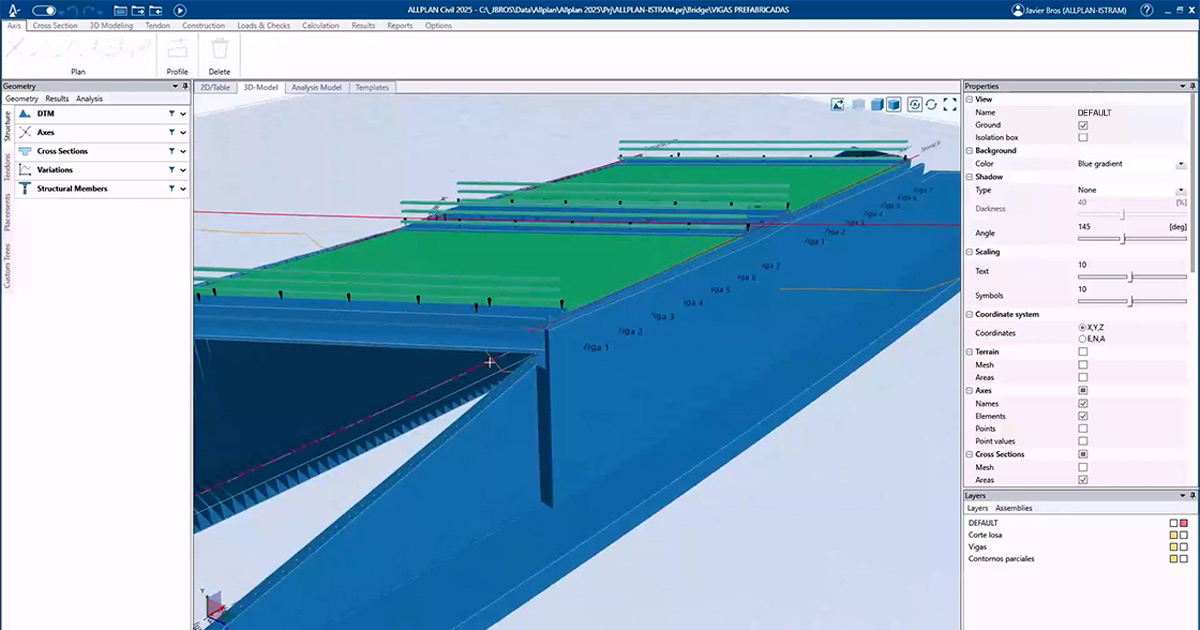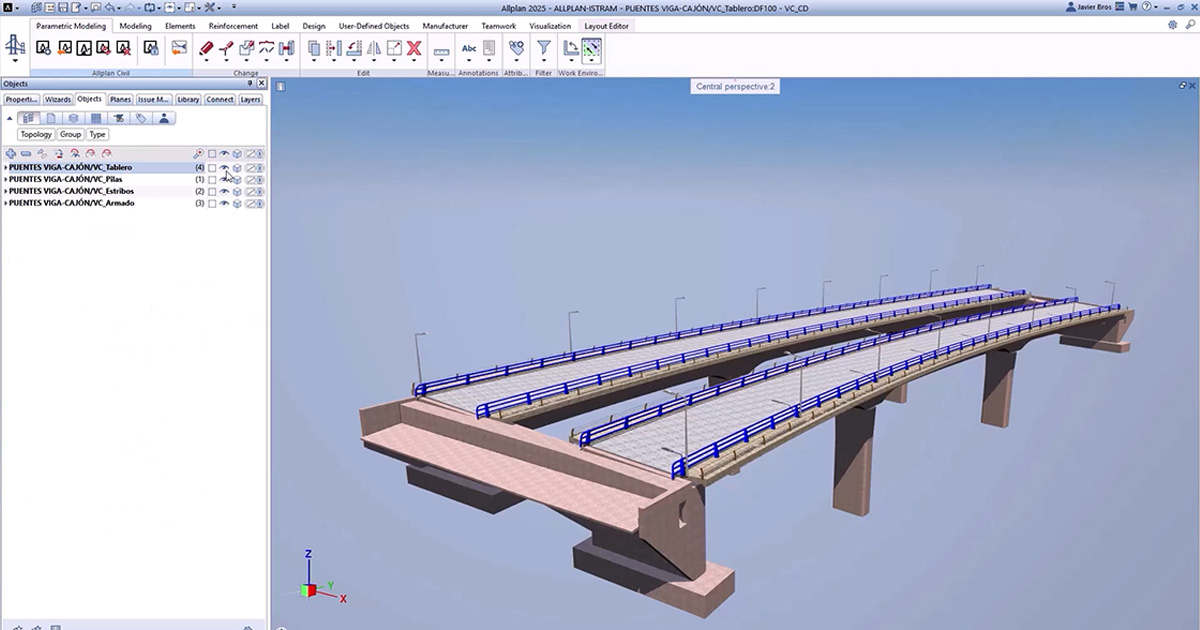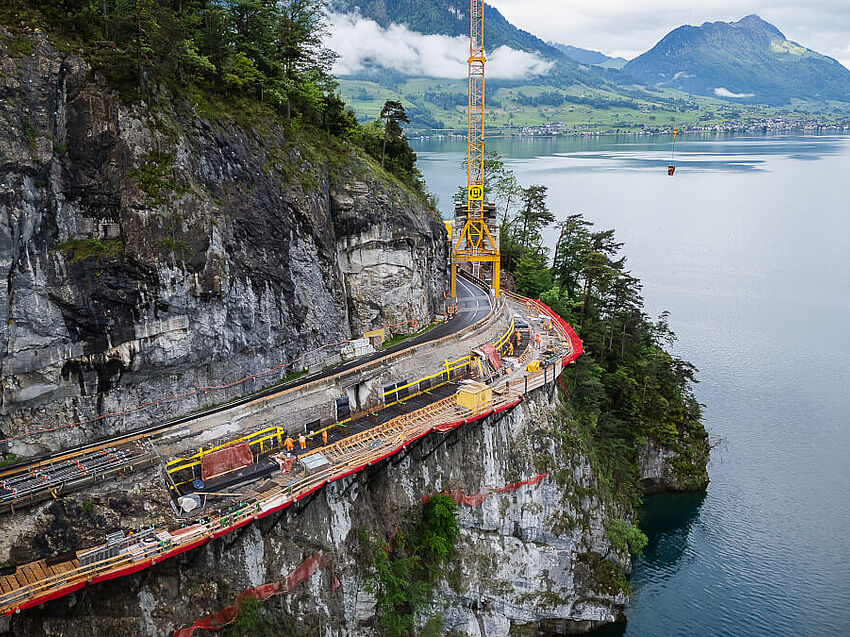Designing large-scale infrastructure isn’t just about connecting two points on a map – it’s about managing complexity, precision, and collaboration across every element of the built environment. For a recent demonstration project, ALLPLAN Spain and ISTRAM set out to prove how a fully integrated BIM workflow could handle all of it – from terrain and axis geometry to tunnels, bridges, and everything in between.
Together, they developed a 6 km dual carriageway featuring four major structures, modeled and validated in parallel using ISTRAM, ALLPLAN Civil, and the OpenBIM platform BIMPLUS. The result is a clear, replicable workflow for infrastructure teams tackling challenging linear projects with confidence and clarity.
From Concept to Corridor – Building the Digital Backbone
The project began with ISTRAM, where the horizontal and vertical alignment of the highway was defined using LandXML. ISTRAM’s modeling environment is especially well-suited to large-scale projects, enabling the design team to generate and validate geometry quickly with tools for rule-based alignment checks, axis connections, and regression methods.
To build the terrain model, the team worked from a dense point cloud filtered to cover only the relevant corridor area. After triangulation, this terrain was exported – also via LandXML – and brought into ALLPLAN. From there, it was uploaded to BIMPLUS, making it available across platforms and disciplines.
With the axis, terrain, and corridor data fully defined and shared, the team had the foundation they needed to begin modeling each structure in ALLPLAN Civil.

Intelligent Infrastructure Modeling with ALLPLAN Civil
From the start, ALLPLAN Civil proved essential for modeling civil structures with precision. By importing ISTRAM data via BIMPLUS and IFC 4.3, the team was able to work with fully georeferenced geometry, allowing for seamless positioning and alignment throughout the corridor. A further advantage of the workflow is that no coordinate transformation is required between ISTRAM and ALLPLAN – both platforms read and manage geometry directly in real-world CRS coordinates, ensuring consistency and reducing the risk of errors.
Parametric tools in ALLPLAN Civil made it possible to work with complex and variable geometry – ideal for elements like curved tunnel profiles or bridges with skewed abutments. These tools allowed the design team to test, adapt, and validate geometry without needing to rebuild components from scratch. Across the entire workflow, geometry and metadata remained consistent, accurate, and easily accessible.

Four Structures, One Integrated Workflow
To demonstrate the versatility of the workflow, four very different structures were modeled and coordinated as part of the corridor. Each one presented distinct design challenges – all of which were solved using the combined capabilities of ISTRAM and ALLPLAN Civil.
Skewed Precast Bridge
At one of the highway’s intersections, a precast bridge was modeled with angled abutments. Using the lower axis geometry, the abutments and wing walls were aligned perfectly to site constraints. Detailing included neoprene bearings, precast girders, and connections to roadside guardrails, lighting columns, and railings – all directly modeled in ALLPLAN and coordinated with surrounding elements.
Twin-Tube Tunnel with Access Gallery
Further along the route, the team modeled a twin-tube tunnel with a central connecting gallery. The tunnel featured a variable cross-section with three radii and an asymmetric sidewalk – modeled entirely parametrically in ALLPLAN Civil. Detailed elements included ventilation systems, cable ducts, and signage. This level of detail ensured the tunnel was ready not just for design approval, but for construction planning and review.
Post-Tensioned Box Girder Bridge
Another highlight was a prestressed concrete hollow box girder bridge, where ALLPLAN Civil was used not just for modeling, but also for structural analysis and reinforcement design. Tendons were modeled inside the structure and analyzed directly. Engineers could then generate moment diagrams, internal force reports, and reinforcement quantities, all within the same platform. Final reinforcement models were produced based on these calculations, with complete code checking and documentation.
525m Cable-Stayed Bridge
At the heart of the project stood a 525-meter cable-stayed bridge – the longest span in the corridor. Featuring two 105-meter pylons and 80 cables, the bridge included a range of custom geometry. The pylon bases, with their rounded support structures, were modeled and detailed in ALLPLAN Civil. Every element – from the cable anchor points to the abutments and holdback systems – was coordinated in 3D and integrated into the corridor model for review and adjustment.

Coordinated, Verified, and Ready to Build
At each stage, data flowed between ALLPLAN Civil and ISTRAM via the IFC 4.3 standard, ensuring that axis geometry, terrain surfaces, and 3D objects could be validated and adjusted as needed. Using BIMPLUS as a central coordination hub allowed the team to check for consistency, share updates, and track progress across platforms.
This bidirectional workflow ensured that models remained accurate, and that each software environment could play to its strengths – ISTRAM for corridor definition and road geometry; ALLPLAN Civil for structure modeling, reinforcement, and analysis.

A Proven Workflow for Modern Infrastructure Projects
By combining the strengths of ISTRAM and ALLPLAN Civil, this project showcased a complete, coordinated, and highly adaptable workflow for infrastructure design. From highways and tunnels to skewed bridges and long-span cable-stayed structures, everything was modeled with accuracy, checked for compliance, and ready for construction documentation, all within a common OpenBIM framework.
That’s more than just a real-life use case – it’s a blueprint for how infrastructure teams can work today: collaboratively, intelligently, and with full confidence in their tools.




